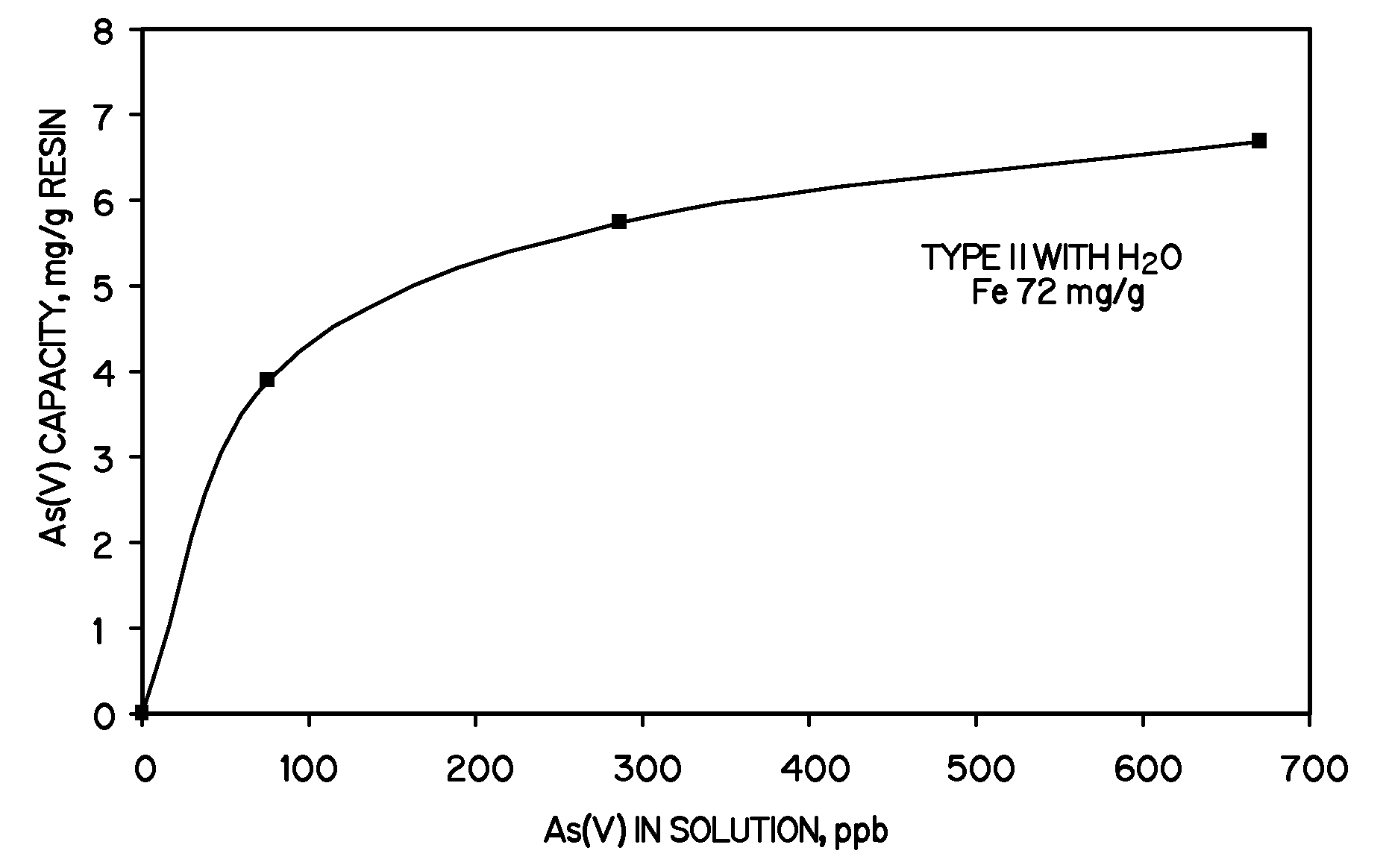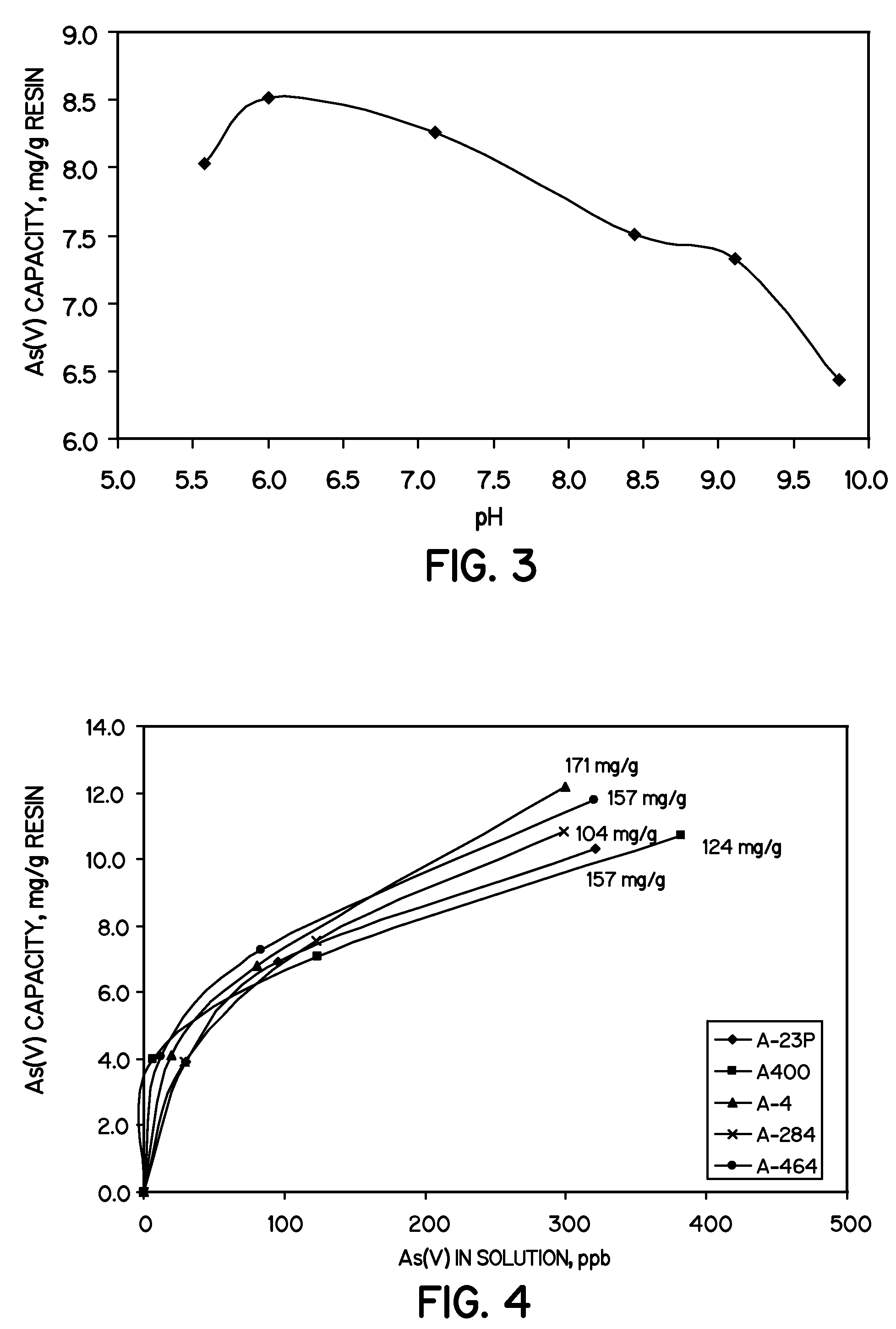Method and sorbent for selective removal of contaminants from fluids
a technology of sorbent and contaminants, applied in the direction of water/sewage treatment by ion exchange, ion exchanger, chemistry apparatus and processes, etc., can solve the problems of inability to use fine hfo particles in fixed beds, inability to pass through systems, and inability to permeate reactive barriers,
- Summary
- Abstract
- Description
- Claims
- Application Information
AI Technical Summary
Problems solved by technology
Method used
Image
Examples
example 1
[0024]A gel-type strong base Type II anion exchange resin (34.5 g (50 mL), Tulsion A-32P, Thermax Inc., Novi Mich.) was contacted with 200 mL of 14%w / v FeCl3 in deionized water for one hour. The golden yellow resin beads were separated from the iron (III) chloride solution by filtration and then contacted with 200 mL of 7.5%w / v NaOH for thirty minutes. Unbound HFO, evidenced as brown iron floc, was decanted and the iron-loaded dark red resin was rinsed with tap water until free of loose iron hydroxide. A fresh 200 mL of 14%w / v FeCl3 in deionized water was then added to the iron-loaded resin beads and stirred for one hour (second iron contact cycle). The resin was again separated by filtration and then contacted with 200 mL 7.5%w / v NaOH to precipitate the HFO particles. The residual iron floc was decanted and the beads were washed with tap water until free of loose iron hydroxide. The iron-loaded dark red resin was washed and neutralized with 5% NaCl that was sparged with CO2 to redu...
example 2
[0026]A gel-type strong base Type I anion exchange resin (34.5 g (50 mL) Tulsion A-23P, Thermax Inc., Novi, Mich.) was contacted with 200 mL of FeCl3 in deionized water for one hour. Five different FeCl3 concentrations in water were used: 14%w / v, 21%w / v, 28.5%w / v, 35%w / v and 50%w / v.
[0027]The number of iron contact cycles for each reaction is given in Table 1, showing synthesis reaction conditions.
[0028]
TABLE 1Number ofSamples takenFeCl3 concentrationcyclesat cycleFinal color of beads14%w / v43 and 4dark red / brown21%w / v22dark red / brown28.5%w / v 21 and 2blackish35%w / v21 and 2black50%w / v11orange / red
[0029]After each iron contact cycle, the resin beads were contacted with 200 mL of 7.5%w / v NaOH for thirty minutes, except the resin beads that had been contacted with 50%w / v FeCl3 which were contacted with 10%w / v NaOH for thirty minutes. Each sample was rinsed with tap water before contacting with a fresh iron (III) chloride solution. All samples were neutralized with 5% NaCl that was sparged...
example 3
[0034]The effect of pH on As(V) uptake by the resin beads prepared in Example 2 with 206 mg Fe / g dry material is shown in FIG. 3. Six samples of 0.05 g iron loaded resin were contacted with 200 mL of a simulated contaminated solution. The simulated contaminated solution contained 1 ppm arsenic(V), 120 ppm sulfate, 100 ppm bicarbonate, and 33 ppm chloride. The pH of the solutions was adjusted to the desired pH (pH 5.5, 6.0, 7.0, 8.5, 9.0, about 9.8) with HCl or NaOH. The amount of arsenic remaining in solution was measured after about 18 hr contact with the resin, and the final pH values were recorded. As shown in FIG. 3, the maximum As(V) uptake by the resin beads was obtained at a pH value of pH 6.
PUM
| Property | Measurement | Unit |
|---|---|---|
| Temperature | aaaaa | aaaaa |
| Temperature | aaaaa | aaaaa |
| Dimensionless property | aaaaa | aaaaa |
Abstract
Description
Claims
Application Information
 Login to View More
Login to View More - R&D
- Intellectual Property
- Life Sciences
- Materials
- Tech Scout
- Unparalleled Data Quality
- Higher Quality Content
- 60% Fewer Hallucinations
Browse by: Latest US Patents, China's latest patents, Technical Efficacy Thesaurus, Application Domain, Technology Topic, Popular Technical Reports.
© 2025 PatSnap. All rights reserved.Legal|Privacy policy|Modern Slavery Act Transparency Statement|Sitemap|About US| Contact US: help@patsnap.com



